Display items can feature highly different degrees of lightfastness depending on their material characteristics. Lightfastness in the broadest sense means resistance to discolouration and changes in material structure (surface quality, stability etc.) caused by radiation effects.
Light protection
In addition to visual radiation not only daylight but also artificial light sources can emit short-wave ultraviolet radiation components ranging from 380 nm to 780 nm, namely
UV-A 315 nm to 380 nm,
UV-B 280 nm to 315 nm,
UV-C 100 nm to 280 nm as well as
long-wave heat radiation (infrared IR with over 780 nm).
High-value, sensitive exhibits can be damaged through radiation due to photochemical processes. The consequences are fading, yellowing, darkening of colour pigments and binding agents etc., particularly in textiles, oil paintings, paper and wood, meaning predominantly in organic substances. Materials can also get dried out, discoloured or deformed due to strong heat irradiation.
The main causes of damage are
illuminance E and possibly also radiation components outside the visual spectrum, which includes UV and IR radiation components,
exposure time t, and
material sensitivity.
The product of both parameters E · t is the exposure H (in lx · h) which used to be referred to as dose. The sum of exposure H over all periods of exposure and all irradiation levels constitutes a major cause for damage. Material recovery after prolonged "rest periods" has not been demonstrated.
The effects of radiation depend upon material characteristics, among other things the spectral absorptance of the material. The more radiation is absorbed in the various spectral regions, the higher the risk of damaging effects of overall radiation.
Cause (radiation) and damaging effect (e.g. fading) only show a linear connection initially. After long periods of time, the damage increases insignificantly in spite of ongoing radiation stress (cause) – as a consequence of e.g. possibly intentional pre-exposure (figure a).
In museum, exhibition and gallery lighting (see chapter ), conservation-related lighting criteria, meaning integrity of exhibits, are of much more importance than in retail space lighting. The sector initiative "licht.de" has published a document on museum lighting, which is available for free download (only in German) at www.licht.de. It outlines conservation-related criteria based on recent research results in great detail.
For retail space lighting, these concerns are generally significantly less critical, except for food presentation. Still, merchandise displays should be changed after certain amounts of time, and merchandise should be relocated or rearrangred, which is also advisable for promotional reasons. Furthermore, high illuminance should only be active during business hours, and not during e.g. cleaning periods, to reduce radiation time and also lighting costs.
It is commonly known that e.g. textiles fade in daylight, which happens uniformly over an entire piece of clothing. In the retail space, merchandise must therefore be relocated or rearrangred frequently in order to prevent focussing the effects of lighting on certain parts of the presentation.
Besides material-specific absorptance for UV, visual and IR radiation, the spectral composition of light is decisive for the damaging effects. Table shows the ranking order of light sources regarding their damaging effects at identical illuminance and exposure time (meaning with the same irradiation or dose), which can, however, be reduced using UV filters with varying filter edges. The filter edge determines the radiation components which are filtered out and therefore do not reach the object. The more damaging radiation components are filtered out, the lower the damaging impact. Daylight causes the most pronounced damage.
The table values refer to the damaging effects of (unfiltered) fluorescent lamp light with daylight-white light colour or low-voltage halogen lamps (100%). According to filter properties (filter edge for wavelength in nm) or through window glass (e.g. shop windows or exhibition cabinets), damaging effects can be reduced. For example, if an object is illuminated using metal halide lamps and a filter shutting out radiation below 380 nm (simple UV protection), the damaging effects are still nearly twice as severe (180%) as is the case with radiation from low-voltage halogen lamps (100%). Differently put: An object can be illuminated nearly twice as long or nearly twice as brightly with the (unfiltered) light of a low-voltage halogen lamp as is possible with the light of a metal halide lamp with simple UV protection.
UV filters, e.g. for tungsten halogen lamps or metal halide lamps protect textiles, leather and furs; IR absorbers protect sensitive materials like furs, food and flowers. Combined UV and IR filters are all-purpose. However, it must be taken into account that filters reduce the lamps’ luminous flux and thus illuminance.
UV-A filters provide protection against radiation at a wavelength of 315 nm to 380 nm and increase the permissible exposure (product of illuminance and exposure time) for merchandise. Colour fastness testing of textiles to light is regulated in the series of standards EN ISO 105 "Textiles – Tests for colour fastness", more specifically
in part B01: "Colour fastness to light: Daylight",
in part B02 "Colour fastness to artificial light: Xenon arc fading lamp test", and
in part B06 "Colour fastness and ageing to artificial light at high temperatures: Xenon arc fading lamp test".
This series of standards has been implemented through national standards in many European countries.
Table a) provides exposure thresholds in kilolux hours (klxh) for many practical application scenarios. 1.000 klxh mean e.g. that after 1.000 hours, a change in visual appearance of the fabric becomes visible if the merchandise was illuminated at 1.000 lx during that time. The table values are average ranges, which can vary significantly over even greater ranges in part due to highly different absorption of fabrics.
For a practical assessment of fading in materials, lightfastness degrees can be consulted. They provide the permissible exposure time in hours, over which materials can be exposed to daylight at 1.000 lx without resulting damage. The permissible exposure time roughly doubles from degree to degree. According to table b) a material with lightfastness degree 8 can be exposed to daylight at 1.000 lx circa 67 times longer than fabrics with lightfastness degree 2.
The influence of spectral composition on permissible exposure time is depicted in figure b). In relation to the reference illuminance of 1.000 lx, the fading effects of daylight are always more severe than those of artificial light sources.
Filters can extend the exposure time. According to filter type, there are various extension factors (table). For particularly sensitive exhibits as they are found e.g. in museums, conservation-related lighting aspects are also relevant.
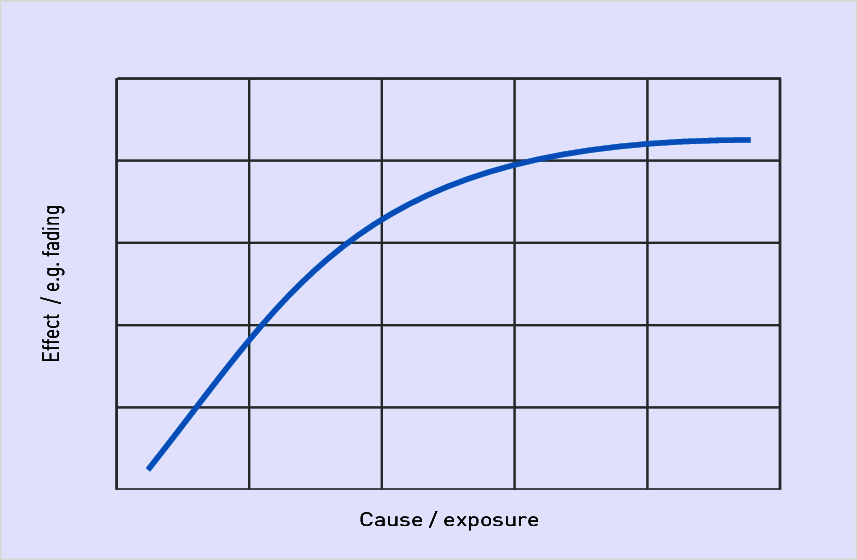
(a) Fundamental relation between cause (exposure) and effect (e.g. fading)
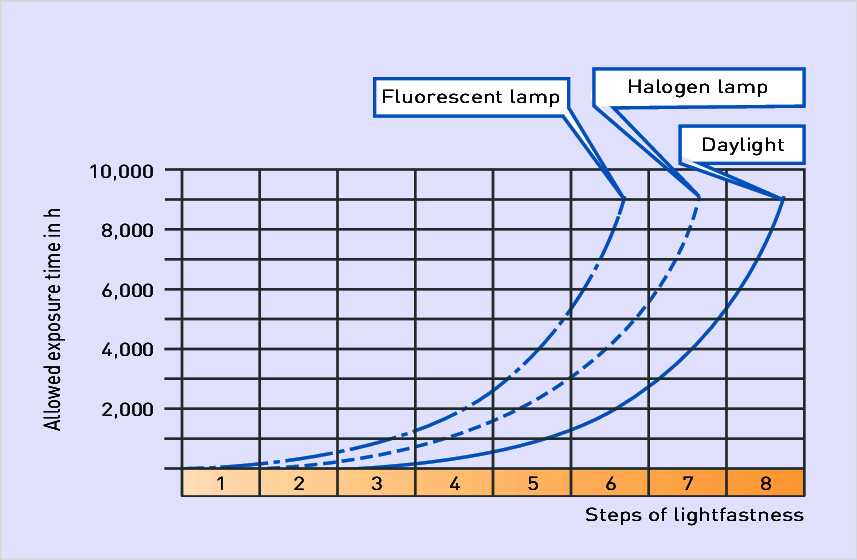
(b) Permissible exposure times for 1.000 lx illuminance on the exhibit for different light sources
Figure 3.148: Fading due to exposure

Table 3.119: Relative damaging impact in % caused by different light sources and their filters
Example
A sensitive leather jacket with a lightfastness degree (assumed to be extremely low) of 2 is illuminated using low-voltage halogen projectors with cold light reflector and UV-A elimination filter at 2.000 lx. The permissible exposure time at 1.000 lx of daylight (see table b) is 150 hours. With 2.000 lx on the exhibit using the UV-A filter, the jacket can be illuminated for 300 hours (extension factor for halogen lamps and UV-A filters 4,0 see table) without causing damage.

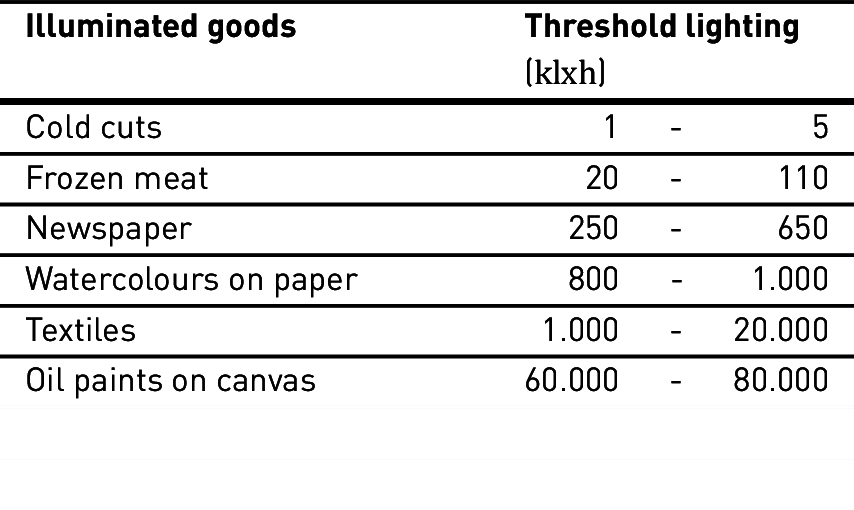
(a) Exposure thresholds and lightfastness degrees
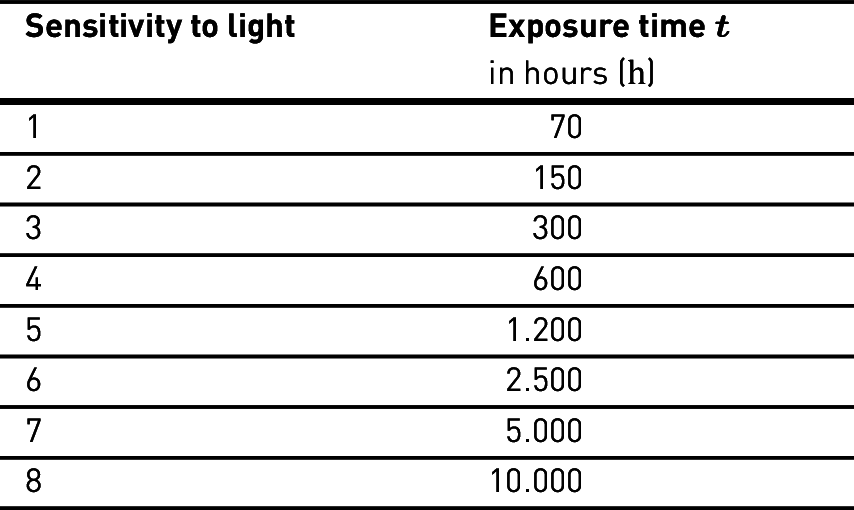
(b) Degrees of lightfastness and maximum exposure time at 1,000 lx daylight
Table 3.120: Exposure thresholds and lightfastness degrees
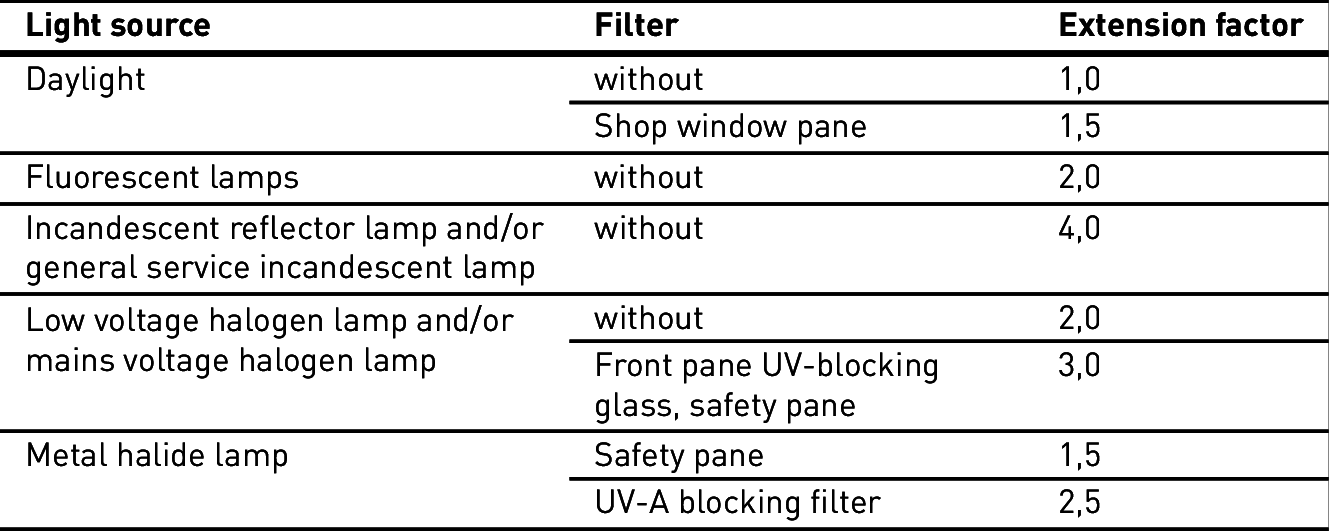
Table 3.121: Extension factors for exposure time according to table 1.11-7 for different light sources and filters
Lightfastness degree 2 means that this jacket can only be exposed to 1.000 lx daylight illuminance for 150 hours, otherwise there will be noticeable discolourations. A clouded sky provides as much as 5.000 lx, which reduces this time to 30 hours. However: Uniform discolouration is mostly seen to be less critical than a partial discolouration which is significantly more noticeable.